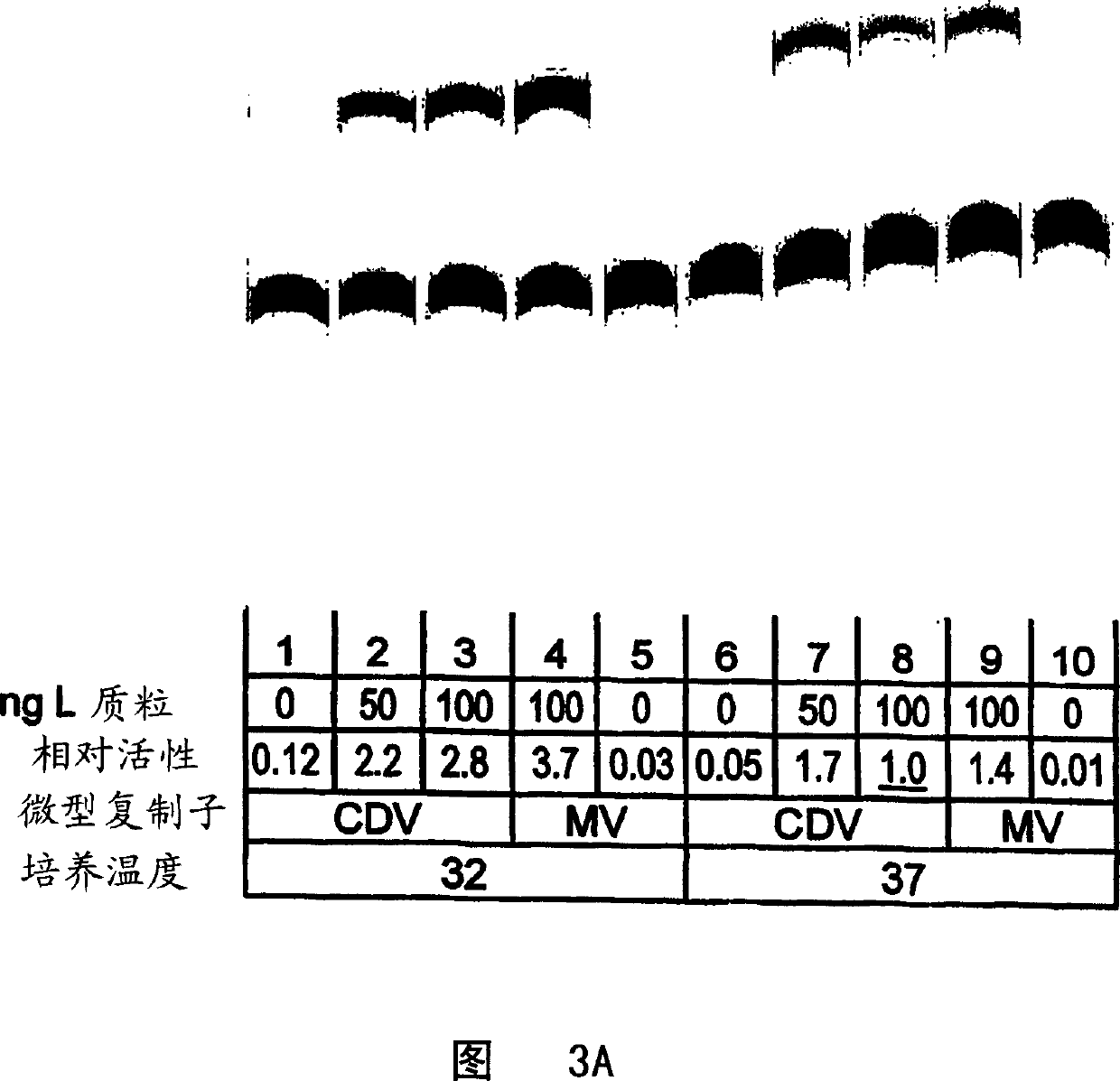Rescue of canine distemper virus from CDNA
A technology for canine distemper and virus, applied in the field of producing canine distemper virus as attenuated and/or infectious virus, immunogenic composition, immunogenic or therapeutic composition, which can solve the problem of inability to use susceptible Issues with animal populations, inability to grow efficiently, no minireplicon or viral rescue systems have been reported
- Summary
- Abstract
- Description
- Claims
- Application Information
AI Technical Summary
Problems solved by technology
Method used
Image
Examples
example 1
[0145] Materials and methods
[0146] Cells and viruses
[0147] HEp2, A549, Vero, B95-8 and chicken embryo fibroblast (CEF) cells are maintained in Dulbecco's modified Eagle medium (DMEM) supplemented with 10% fetal bovine serum (FBS). HeLa suspension cells were grown in modified minimal essential medium (SMEM) supplemented with 5% FBS. The laboratory-modified Onderstepoort CDV strain (17) was propagated in HeLa cells according to the previously disclosed method (46). The second laboratory-modified Onderstepoort strain was provided by Dr. Martin Billeter of Zurich University and was propagated in B95-8 cells. Propagation of the recombinant attenuated vaccinia virus strain MVA / T7 (obtained from Dr. B. Moss, National Institute of Health, Bethesda, MD; Wyatt et al., 1995; reference 61) designed to express the T7 RNA polymerase gene in CEF cells ). Titrate the MVA / T7 mother liquor on CEFs. A laboratory modified Edmonston strain of measles virus (MV) grown in HeLa suspension cells (55...
example 2
[0179] General method of transient expression analysis and virus rescue by CAT assay
[0180] The microreplicon transfection is performed by several methods. For experiments using CDV microreplicon as RNA for transfection, 293 cells were transfected with Lipofectace (Life Technologies). The microreplicon RNA is prepared in vitro by T7 RNA polymerase using pCDV-CAT DNA (Figure 1B) as a transcription template (2). The RNA was synthesized and purified using the reagents and methods in the Megascript kit (Ambion). In the compensated microreplicon experiment provided by CDV infection (Figure 2A), the components of the RNA transfection mixture were prepared in two test tubes. One test tube contains 20 micrograms of purified microreplicon RNA and 100 microliters of serum-free OptiMEM (Life Technologies). The second test tube was prepared with 100 microliters of serum-free OptiMEM and 9-12 microliters of Lipofectace (Life Technologies). Then mix the contents of the two test tubes and incu...
example 3
[0185] CDV microreplicon expression. For the development of a virus rescue system, it is important to use the microreplicon reporting system for transient expression studies. By analyzing the transient expression of the microreplicon reporting gene, the transfection parameters can be evaluated relatively quickly to determine the optimal conditions, and it is still A valuable tool for determining whether N, P, and L expression vectors can guide the synthesis of functional proteins.
[0186] 3.1 Save the CDV microreplicon by virus
[0187] 3.1.1 The microreplicon experiment tested whether the CDV-CAT microreplicon can exert its ability to be rescued by virus compensation. The CDV-CAT microreplicon RNA (20 micrograms) synthesized in vitro was transferred to a 60 mm petri dish of 293 cells. At the beginning of transfection, the cells were also infected with a similar CDV at a multiplicity of infection of approximately 2. About 24 hours after transfection, when about 70% of the cells h...
PUM
 Login to View More
Login to View More Abstract
Description
Claims
Application Information
 Login to View More
Login to View More - R&D
- Intellectual Property
- Life Sciences
- Materials
- Tech Scout
- Unparalleled Data Quality
- Higher Quality Content
- 60% Fewer Hallucinations
Browse by: Latest US Patents, China's latest patents, Technical Efficacy Thesaurus, Application Domain, Technology Topic, Popular Technical Reports.
© 2025 PatSnap. All rights reserved.Legal|Privacy policy|Modern Slavery Act Transparency Statement|Sitemap|About US| Contact US: help@patsnap.com



